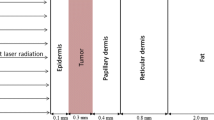Abstract
Laser surgery, or laser-induced thermal therapy, is a minimally invasive alternative or adjuvant to surgical resection in treating tumors embedded in vital organs with poorly defined boundaries. Its use, however, is limited due to the lack of precise control of heating and slow rate of thermal diffusion in the tissue. Nanoparticles, such as nanoshells, can act as intense heat absorbers when they are injected into tumors. These nanoshells can enhance thermal energy deposition into target regions to improve the ability for destroying larger cancerous tissue volumes with lower thermal doses. The goal of this paper is to present an integrated computer model using a so-called nested-block optimization algorithm to simulate laser surgery and provide transient temperature field predictions. In particular, this algorithm aims to capture changes in optical and thermal properties due to nanoshell inclusion and tissue property variation during laser surgery. Numerical results show that this model is able to characterize variation of tissue properties for laser surgical procedures and predict transient temperature fields comparable to those measured by in vivo magnetic resonance temperature imaging techniques. Note that the computational approach presented in the study is quite general and can be applied to other types of nanoparticle inclusions.







Similar content being viewed by others
References
Baer R, Neuhauser D, Weiss S (2004) Enhanced absorption induced by a metallic nanoshell. Nano Lett 4(1):85–88
Benson SJ, McInnes LC, Moré J, Sarich J (2005) TAO user manual (revision 1.8). Technical Report ANL/MCS-TM-242, Mathematics and Computer Science Division, Argonne National Laboratory. http://www.mcs.anl.gov/tao
Brigger I, Dubernet C, Couvreur P (2002) Nanoparticles in cancer therapy and diagnosis. Adv Drug Deliv Rev 54(5):631–51
Demkowicz L, Rachowicz W, Devloo Ph (2002) A fully automatic hp-adaptivity. J Sci Comput 17(1–3):127–155
Diller KR, Valvano JW, Pearce JA (2005) Bioheat transfer. In: Kreith F, Goswami Y (eds) The CRC handbook of mechanical engineering, 2nd edn. CRC Press, Boca Raton, pp 4–278–4–357
Feng Y, Rylander MN, Bass J, Oden JT, Diller K (2005) Optimal design of laser surgery for cancer treatment through nanoparticle-mediated hyperthermia therapy. In: NSTI-Nanotech 2005, vol 1. pp 39–42
Ferrari M (2005) Cancer nanotechnology: opportunities and challenges. Nat Rev Cancer 5(3):161–171
Hindman JC (1966) Proton resonance shift of water in the gas and liquid states. J Chem Phys 44:4582–4592
Hirsch LR, Stafford RJ, Bankson JA, Sershen SR, Rivera B, Price RE, Hazle JD, Halas NJ, West JL (2003) Nanoshell-mediated near-infrared thermal therapy of tumors under magnetic resonance guidance. Proc Natl Acad Sci 100(23):13549–13554
Jain PK, El-Sayed IH, E-Sayed MA (2007) Au nanoparticles target cancer. nanotoday
Lin A, Hirsch L, Lee MH, Barton J, Halas N, West J, Drezek R (2004) Nanoshell-enabled photonics-based imaging and therapy of cancer. Technol Cancer Res Treat 3(1)
Masters A, Steger AC, Lees WR, Walmsley KM, Bown SG (1992) Interstitial laser hyperthermia: a new approach for treating liver metastases. Br J Cancer 66(3):518–522
Nagata Y, Hiraoka M, Akuta K, Abe M, Takahashi M, Jo S, Nishimura Y, Masunaga S, Fukuda M, Imura H (1990) Radiofrequency thermotherapy for malignant liver tumors. Cancer 65(8):1730–1736
Nau WH, Roselli RJ, Milam DF (1999) Measurement of thermal effects on the optical properties of prostate tissue at wavelengths of 1, 064 and 633 nm. Lasers Surg Med 24(1):38–47
Niemz MH (2004) Laser-tissue interactions: fundamentals and applications, 3rd edn. Springer, Berlin
Oden JT, Diller KR, Bajaj C, Browne JC, Hazle J, Babuška I, Bass J, Demkowicz L, Feng Y, Fuentes D, Prudhomme S, Rylander MN, Stafford RJ, Zhang Y (2007) Dynamic data-driven finite element models for laser treatment of prostate cancer. Num Meth PDE 23:904–922
Olsrud J, Wirestam R, Brockstedt S, Nilsson AMK, Tranberg KG, Ståhlberg F, Persson BRR (1998) MRI thermometry in phantoms by use of the proton resonance frequency shift method: application to interstitial laser thermotherapy. Phys Med Biol 43(9):2597–2613
Pennes HH (1948) Analysis of tissue and arterial blood temperatures in the resting forearm. J Appl Physiol 1:93–122
Robinson DS, Parel JM, Denham DB, Gonzalez-Cirre X, Manns F, Milne PJ, Schachner RD, Herron AJ, Comander J, Hauptmann G (1998) Interstitial laser hyperthermia model development for minimally invasive therapy of breast carcinoma. J Am Coll Surg 186(3):284–292
Rylander MN, Feng Y, Bass J, Diller KR (2005) Thermally induced injury and heat-shock protein expression in cells and tissues. Ann N Y Acad Sci 1066:222–242
Rylander MN, Feng Y, Zhang J, Bass J, Stafford RJ, Hazle J, Diller K (2006) Optimizing hsp expression in prostate cancer laser therapy through predictive computational models. J Biomed Opt 11:4:041113
U.S. National Institutes of Health. National Cancer Institute. http://www.cancer.gov
Welch AJ, van Gemert MJC (1995) Optical-thermal response of laser-irradiated tissue. Plenum Press, New York
Welsh AJ, Gardner C (2002) Optical and thermal response of tissue to laser radiation. In: Waynant RW (ed) Lasers in medicine, Chap. 2. pp 27–45
Wust P, Hildebrandt B, Sreenivasa G, Rau B, Gellermann J, Riess H, Felix R, Schlag PM (2002) Hyperthermia in combined treatment of cancer. Lancet Oncol 3(8):487–497
Yang R, Sanghvi NT, Rescorla FJ, Kopecky KK, Grosfeld JL (1993) Liver cancer ablation with extracorporeal high-intensity focused ultrasound. Eur Urol 23(1):17–22
Acknowledgments
The support of this work by the National Science Foundation under grant CNS-0540033 and by National Institutes of Health under Small Animal Imaging Facility core grant CA 16672 are gratefully acknowledged.
Author information
Authors and Affiliations
Corresponding author
Rights and permissions
About this article
Cite this article
Feng, Y., Fuentes, D., Hawkins, A. et al. Nanoshell-mediated laser surgery simulation for prostate cancer treatment. Engineering with Computers 25, 3–13 (2009). https://doi.org/10.1007/s00366-008-0109-y
Received:
Accepted:
Published:
Issue Date:
DOI: https://doi.org/10.1007/s00366-008-0109-y




